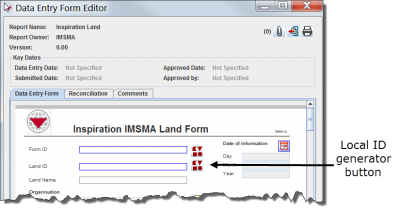Configuring the Items ID Generator
IMSMANG provides a local identifier (local ID) data element for each item category or subcategory, which when used on data entry forms allows information managers to track items and Data Entry Forms entered into IMSMANG. These local ID data elements enable data entry clerks to click a button and insert an automatically generated ID rather than enter one manually, helping to reduce duplicate local IDs in the system. The local ID generator enables you to define a numbering scheme for an object ID, for example, the Report ID, Accident ID, or Victim ID, on a Data Entry Form template. Once the numbering scheme is defined, users can automatically assign IDs to objects each time they add a Data Entry Form with an object ID field to IMSMA.
| How To |
|---|
IMSMANG comes with a default local ID generator per item, but there is no limit to how many different types can be created. It is recommended to create at least one local ID generator per item subcategory. For example, create a local ID generator for completion reports, another for clearance reports and another for minefields. Also, establishing a convention for the local ID generators makes it easy to understand and find data.
